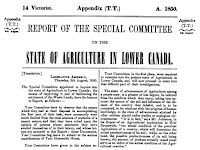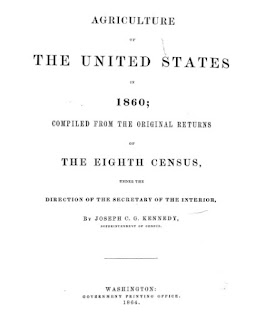For example, in his seminal book The
French-Canadian Heritage in New England Gerard J. Brault writes,
The nineteenth-century Quebec farmer, like
his New England counterpart, tilled the soil, planted, and harvested according
to age-old custom and stubbornly resisted any change. He did not use manure or
any other kind of fertilizer, kept turning over the same old top soil with a shallow
plow, sowed unclean and unimproved seed, allowed weeds to grow everywhere, and
knew nothing about crop rotation.1
A generation before Brault, agricultural
historian Robert Leslie Jones gave a more detailed
account of the alleged shortcomings of 19th c. French-Canadian farmers. Jones set these
farmers against the background of the standard theory that Lower Canada (Québec)
faced an agricultural crisis in the first half of the century.
During this period, writes Jones,
Nothing the habitants could do, seemingly,
promised economic salvation. By mid-century their situation had become one of
chronic distress. Clergy, businessmen, newspaper editors, and politicians
continually discussed it. They agreed in their analyses of the more obvious defects
of agriculture in the St. Lawrence Valley – lack of fertilizing, lack of proper
rotation, lack of approved stock-raising methods, lack of improved implements,
too much concentration on wheat – but they showed much difference of opinion
when they tried to account for these defects.2
The 19th c. French-Canadian
farmer became a problem for “clergy, businessmen, newspaper editors, and
politicians” to solve. It was not enough for them to make suggestions for improving the efficiency
of farms. Elites also felt compelled to “account for these defects” in
French-Canadian agriculture. The seigneurial system of land tenure was among
the alleged causes of what Jones calls the “bad farming of the French-Canadians”
and the “backwardness of the seigneuries.” Others blamed overpopulation in the region,
poor access to markets, and a lack of formal instruction in agriculture.
 |
| 19th c. Habitants: Bad Farmers? |
Another reason Jones cites as “commonly
given” for the supposed “backwardness” of Québec farming was the “ingrained
conservatism of the habitants.” He invokes this alleged trait to impute the futility
of government sponsored efforts toward agricultural education. Behind this
conservative posture, says Jones, lurked “the spirit of French-Canadian
nationalism.” “Dedicated as they were to the preservation of their laws, their
language, and their religion,” Jones writes, “they resisted any change, however
small, in their mode of life. It was this aversion to innovation which rendered
the distress in the seigneuries so acute, and made it so difficult to
ameliorate.”3
Thus the biggest problem with the 19th c. French-Canadian farmers, according to Jones, is that they were
French-Canadian. For Jones, had they stopped being French-Canadian, i.e.,
had they ceased to remain a people distinct as to “their laws, their language, and
their religion,” then they would have been more open to “innovation”
and their agricultural deficiencies would not have been “so difficult to
ameliorate.” Jones suggests that “French-Canadian nationalism,” i.e. the desire
of the French-speaking person of Québec to remain such, was a major cause
of their alleged “bad farming.”
The 1850 Report on Lower Canada’s Agriculture
One of the documents Jones relied upon was an 1850
report of a special committee on agriculture filed with the Legislative
Assembly of Canada.4 This committee had the parliament's mandate to investigate the
state of agriculture in Lower Canada, to make recommendations for its improvement,
and to address the disposition of crown lands. The report includes many pages of expert testimony submitted in writing.
 |
| Report of the Special Committee on Agriculture for the Legislative Assembly of Canada (1850) |
The report identifies “three capital vices”
in Lower Canadian agriculture: “One relates to manure, another to the rotation
of crops, and the third to the raising of cattle.” Another defect is too
much land sown with a single crop: wheat, the principle product for market. Poor drainage is also an often-cited problem.
But this report lacks hard data to compare Lower Canada’s agriculture with that of other regions
of North America. The report assumes that Lower Canadian farming is in a bad
state, and much worse off than the best European operations. However, what little data
is cited shows that in 1831, when insects that had devastated other 19th c. harvests were not a factor, Lower Canada's wheat output per capita was marginally
higher than Upper Canada’s (i.e. Ontario's) and much higher than that of the United States. Even
if French-Canadian farmers could have markedly improved their yields by using better
methods, in terms of production of the staple crop they held their own with other North Americans all things being equal.
U.S. Farmers – Equally As Bad?
If mid-19th century
French-Canadian farmers were bad, then their U.S. counterparts were little
better. U.S. farms were also beneath the bar set by European agriculture. And the very same defects that observers claimed impeded
French-Canadian agriculture beset U.S. farmers as well.
Consider the 1864 report by Joseph C. G. Kennedy, produced under
the auspices of the U.S. Secretary of the Interior based on data from the 1860 Federal Census.5 Although this document is mainly quantitative in character, as befits the author’s position as Superintendent of the census, it is the qualitative description of U.S.
farming in Kennedy's introduction that is relevant to the present discussion.
“It has been said that American
agriculture is half a century behind that of Great Britain,” writes Kennedy. “Our
land is not as thoroughly under-drained, manured, and cultivated as that of England,
Scotland, or Belgium.” Kennedy cites an English journal’s prediction that the
U.S. would become an importer rather than an exporter of grain due to the American's "scourging" system of agriculture that exhausted the land.
Replying to these criticisms, Kennedy unwittingly reveals the defects in U.S. farming. Conceding that poor farming methods had exhausted some lands, Kennedy writes,
That any of our so-called exhausted land
can be speedily restored to its original fertility, we have abundant evidence.
All that is necessary, is to cultivate the soil more thoroughly, under-drain where
it is wet, sow less grain and more clover and grass, keep more stock, and make
more and richer manure….
American agriculture is in a transition
state. In the older-settled sections of the country there is much land that has
been exhausted of its original fertility. Here the old system of farming, which was
simply to raise all the grain that the land would produce, is no longer
profitable. But yet some farmers, with that aversion to change for which they
are everywhere proverbial, are slow to adopt an intelligent system of rotation
and manuring, and cling to their old ways.6
Kennedy’s account shows that the alleged
defects of at least "some" U.S. farmers were identical to those ascribed to their Lower
Canadian counterparts. These defects, common to both countries, included poor fertilization, poor drainage, and inadequate rotation
of crops; insufficient livestock; and sowing too much land with a single crop. The same “ingrained
conservatism” Jones attributed to French-Canadian farmers Kennedy bestowed upon
their U.S. colleagues. But where Jones made this conservatism a national trait of the French-Canadians, Kennedy attributes it to the
occupation of the farmer. Clinging to old ways is, for him, an occupational hazard.
He thought that farmers “everywhere” were averse to change.
Whereas the authors of the 1850 Canadian
report, and latter-day scholars like Jones, fretted over the problem of the “ingrained" traits of the French-Canadian farmer, Kennedy pinned his hopes on a younger, can-do generation. “We must look to the intelligent
young men of our country for any great improvement in its agriculture,” Kennedy
writes. “Our young men are beginning to realize that agriculture is worthy [of]
their highest ambition, and that in no other pursuit will intelligent labor
meet with a surer reward.”
Same Facts – Different Frame
Nineteenth-century North American farming, in the U.S. and
Canada alike, appears to have been less scientific than the cream of European agriculture. To explain
the differences between the two continents, Kennedy observes that there was an abundance of
cheap land on the western side of the Atlantic, but a shortage of farm labor. In much of Europe, every cultivable scrap
had been cultivated long ago, and a dense population meant plenty of available farm workers. Geography and demography explain why North American farming was different
from the European brand. North American farmers of the 19th c. had not yet thought to learn
the best methods available in Europe because it hadn’t been in their interest to
do so.
 |
| Kennedy's report on U.S. Agriculture (1864) |
While official reports from the period suggest that the same deficiencies dogged both U.S. and French-Canadian farmers, the frame put around the former was optimistic, while observers depicted the outlook for the latter as decidedly glum.
In contrast to the discourse around the habitants, the defects in U.S. farming were not personalized; modern farming was seen as a set of practices, more or less interchangeable from one farm to another, that a younger generation could learn as the need arose. Kennedy’s report sees U.S. farmers as rational actors who will respond effectively as prompted by self-interest.
On the other hand, observers cast French-Canadian farmers as inertial, influenced to move, if at all, only from the outside. For Kennedy, solutions to the problems of U.S. farming were technical, while, for generations, discussions of French-Canadian agriculture tended to become sociological, for instance Jones's talk about "nationalism" and allegedly "ingrained" traits. Elites pondered not only a change in French-Canadian farming practices, but in the French-Canadians themselves.
Were 19th century French-Canadians bad
farmers? Perhaps by world-class standards but not by North American ones. Especially in the eastern parts of North America, Canadian and U.S. methods
of farming, and the limitations of those methods, were not much different from one another. A similar set of facts
prevailed in many rural regions of North America, but the frame
elites and subsequent observers placed around those facts, depending on whether they were looking at U.S. or at Québec farmers, was markedly different.
------------------------
Much more in my book:
A Distinct Alien Race: The Untold Story of Franco-Americans
------------------------
------------------------
Much more in my book:
A Distinct Alien Race: The Untold Story of Franco-Americans
------------------------
Notes
1. Gerard J. Brault, The
French-Canadian Heritage in New England (Hanover, NH: University Press of
New England, 1986), 52.
2. Robert Leslie Jones,
"French-Canadian Agriculture in the St. Lawrence Valley, 1815-1850," Agricultural
History 16, no. 3 (1942): 145-46.
3. Jones,
148.
4. Journals
of the Legislative Assembly of the Province of Canada, Volume 9, Issue 2, 1850,
Appendix T.T.
5. Joseph C.
G. Kennedy, Agriculture of the United States in 1860, Compiled from the
Original Returns of The Eighth Census, Under The Direction of the Secretary of
the Interior (Washington: Government Printing Office, 1864).
6. Kennedy,
x.
Thank you for this post. Very informative.
ReplyDelete